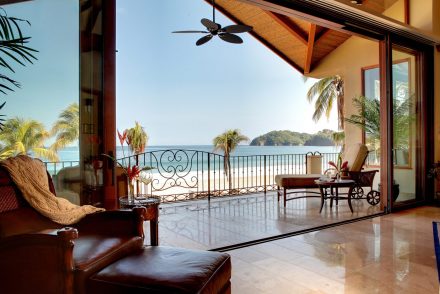The endowment effect is for real.
Peoples’ irrational tendency to overvalue a thing once they take ownership of it has been studied and shown in ownership of coffee mugs, baseball cards, Final Four tickets, even apes and monkeys. In fact, out-of-the-ordinary items prompt especially significant cases of the endowment effect, according to BehavioralEconomics.com.
Of course, most of us probably don’t need an academic lesson to understand what is experientially seen all the time, in real estate markets all over the world: luxury owners consistently price their properties too high. To be sure, the term “luxury” is often used interchangeably with “premium,” aka the extra amount added onto the cost a good commands simply by being so desirable. But how is one to know where the line is between value-added and total ripoff?
We’re taking a look at a few practical ways to know how to assess the value of a luxury home and how to secure a good deal on a vacation home or investment property. After all, even luxury homes are only worth what someone is willing to pay.
Check the Time, But Beware
It’s a well-recognized fact of real estate that the longer a property sits on the market, the lower the sale price ends up being when it finally closes. In one study, Zillow pegged the losses (for all types of properties) at 5% after two months, and 12% after sitting idle for an average of 11 months. The rule of thumb is that a fairly priced home will sell within about 30 days and within 5% of asking.
 However, the luxury market is a different animal. It’s quite common to see high-end properties sitting on the market for months or even years, and when they finally sell, it’s at a severe reduction in the asking price. Unsurprisingly, as luxury real estate auction firm Concierge Auctions reports, the number one determining factor for a luxury property’s sale price is the DOM (days on market).
However, the luxury market is a different animal. It’s quite common to see high-end properties sitting on the market for months or even years, and when they finally sell, it’s at a severe reduction in the asking price. Unsurprisingly, as luxury real estate auction firm Concierge Auctions reports, the number one determining factor for a luxury property’s sale price is the DOM (days on market).
There are a few factors at play here: Because luxury owners are by and large financially secure, they often can literally afford to wait on a buyer to meet an inflated asking price. This poses a problem for buyers–especially international buyers with only internet tools to investigate a property in a foreign country–in that the DOM counters on listing sites may not be reliable.
Take Zillow for example. Zillow’s policy stipulates that if a property has been off the market on its site for at least 32 days, the counter resets. On New York real estate site StreetEasy, the number is 90 straight days, but Realtor.com could reset its clock for a property off-market for just a few days if the home is awarded a new listing ID. Unscrupulous agents are sometimes able to manipulate listings through tweaks that reset the counter, or at least bring the listing back to the top of search results. But if they have an owner who’s in no hurry anyway, it’s the easiest thing in the world to pull the listing for a few months and start all over again with a refreshed DOM counter and the same inflated price.
The bottom line is that you need to have local representation in the area of your desired luxury home that can give you a clear picture of a luxury home and its history. Your biggest bargaining chip will be to know a house has grown stale and that its owner is ready to take a haircut and be done.
Be Prepared to Work without Comps
“Comps,” or comparable homes to the home in question that have sold in the same area within the last six months or a year, are the primary tool appraisers use to craft a final value estimate. Comps also include details such as square footage of the house, number of bedrooms and bathrooms, style of the home, and similar interior finishing and exterior appeal.
This can present a problem in the luxury real estate market: custom luxury homes are unique by design. And as we’ve already seen, they can sit on the market for much longer than a year. If they’re decked out with one-of-a-kind touches unlike anything nearby, locating a comparable property that’s sold recently can be very tough for an appraiser.
 In these cases, the appraiser may turn to the Cost Approach and use something like the National Building Cost Manual. This will give her a method to determine a replacement value for particular aspects of the house, or the cost to build a substitute for it. However, a more accurate valuation would incorporate the reproduction value: the cost for builders to create an exact duplicate using the same materials, construction standards, design, layout, and quality of workmanship, at modern prices.
In these cases, the appraiser may turn to the Cost Approach and use something like the National Building Cost Manual. This will give her a method to determine a replacement value for particular aspects of the house, or the cost to build a substitute for it. However, a more accurate valuation would incorporate the reproduction value: the cost for builders to create an exact duplicate using the same materials, construction standards, design, layout, and quality of workmanship, at modern prices.
When you’re dealing with custom luxury home features, there may be extraordinary materials or craftsmanship involved that give that furnishing or feature its cachet, such as salvaged wood from a historic building or a one-of-a-kind wall mural; simply replacing those premium ingredients with run-of-the-mill components would ruin the whole idea of the piece as built. The trouble is, you’d almost need to be a specialist from Sotheby’s to know how to value some of these features.
As a buyer, this could work to your advantage as an impartial appraiser is likely to view a custom feature in terms of that replacement cost–salvaged wood for salvaged wood, a mural for a mural–despite an owner who spared no expense getting the feature installed and now wants to recover those expenses in the sale.
Think About Selling
With our second tip, we saw what not to do when buying or designing a luxury home–it’s very difficult to get your money back out of really peculiar or unusual features, even when they’re done well. But a good way to add value to your end of the deal when buying a luxe property is to look for features that hold their value well, so that if or when you decide to sell, you get positive ROI.
 Some traits like a great location will always help make a home desirable, but it takes a little more foresight and awareness of how trends are shaping up to gauge value 10 or 20 years down the road. At this time, sustainability features such as solar panels and rainwater-collection systems seem to be the wave of the future. Conversely, we’re already beginning to see rumblings of folks tiring out on the open-concept trend.
Some traits like a great location will always help make a home desirable, but it takes a little more foresight and awareness of how trends are shaping up to gauge value 10 or 20 years down the road. At this time, sustainability features such as solar panels and rainwater-collection systems seem to be the wave of the future. Conversely, we’re already beginning to see rumblings of folks tiring out on the open-concept trend.
Although it’s intended as a reference for making home upgrades, Remodeling.net has a useful tool for researching what types of home features pay off well and which ones don’t, both regionally and nationally. For example, in our region of “West South Central,” a fiberglass grand entrance is an “upscale” addition that returns 67% of its costs, while an upscale master suite addition returns only 48%.
Regardless of their function, high-quality materials can be an excellent way to get value out of a home by helping you avoid maintenance costs and the need to try to recoup expenses when you sell out of the home.
International Luxury Living—Simplified.





No Comments